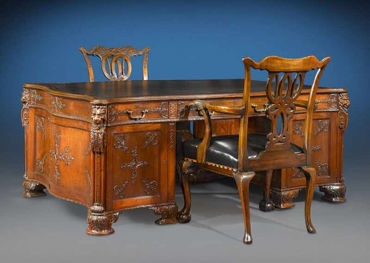Records of the first desk date back to medieval times – illuminated illustrations show scholars resting notebooks and books on flat surfaces. Desks were originally invented for publishers and writers to compile manuscripts. The first desks were complex contraptions, equipped with slots and nooks for writing utensils, and trays for the inkpot, the blotter, and pens.
As technology has changed and advanced, so has the architecture and design of the writing surface. Drawing or drafting tables were invented in the 1700s. Their original design is still seen in drafting tables of today. They were versatile desks that could rise and change positions according to the angle the drawer wanted to achieve. Cabinetmakers started experimenting with the desk design by involving it in their cabinetry.
The bureau Mazarin (named after chief minister of France, Jules Mazarin) became a popular furniture item amongst the French aristocracy. A spider-like device, the Mazarin has 8 legs anywhere from 5 to 15 drawers. The design only allowed for the user to sit in it sideways, with only one knee lodged beneath its drawers. This was because the desk was mainly designed for nobility, who wore swords by their waists, and needed their swords to face outward.
Both the pedestal desk and the rolltop desk came into existence around the 1800s. The pedestal desk is a platform resting on two pedestals, usually made of a series of cabinets or stacked drawers. The first productions of the pedestal desk featured a “modesty panel,” that was situated in between the two pedestals to prevent anyone from seeing the worker’s legs.
The rolltop desk was the last popular wooden desk before the invention of steel and other metal desks. Like many desks of the 18th and 19th centuries, the rolltop had an abundance of drawers on top and below the writing surface. Its distinguishing feature was a cover of wooden slats that could be slid over the surface.
Towards the end of the 19th century and into the 20th, more and more people were starting to work in offices and the demand for desks grew. It was discovered that steel desks could better support typewriters and heavy loads of paper than wooden desks, and they were cheaper and easier to make. As office work became a more staple industry, desk manufacturers were forced to keep up with the flurry of office jobs being created. Eventually, everyone from assistant to CEO started working on a steel desk. In the current start-up climate, the popularity of the single-person desk has diminished, and now office spaces are filled with long, sprawling desks where workers collaborate. Steel desks also help to organize working space and to minimize the working place thus freeing the space for communication and ideas sharing. Such desks also “present” the image of the company and if employees are working at steel desks this unintentionally presents a better image for the visitors to the company.

